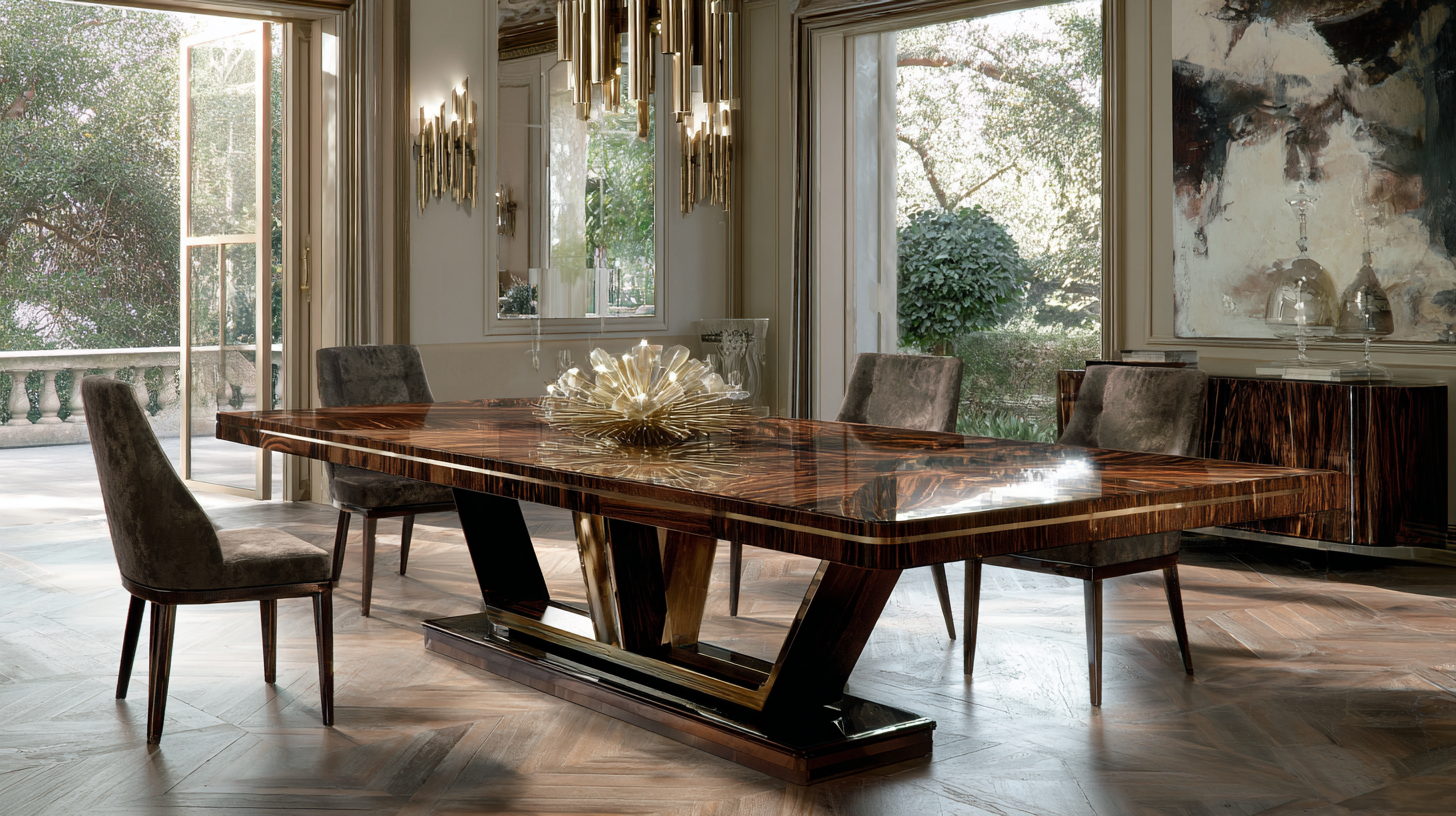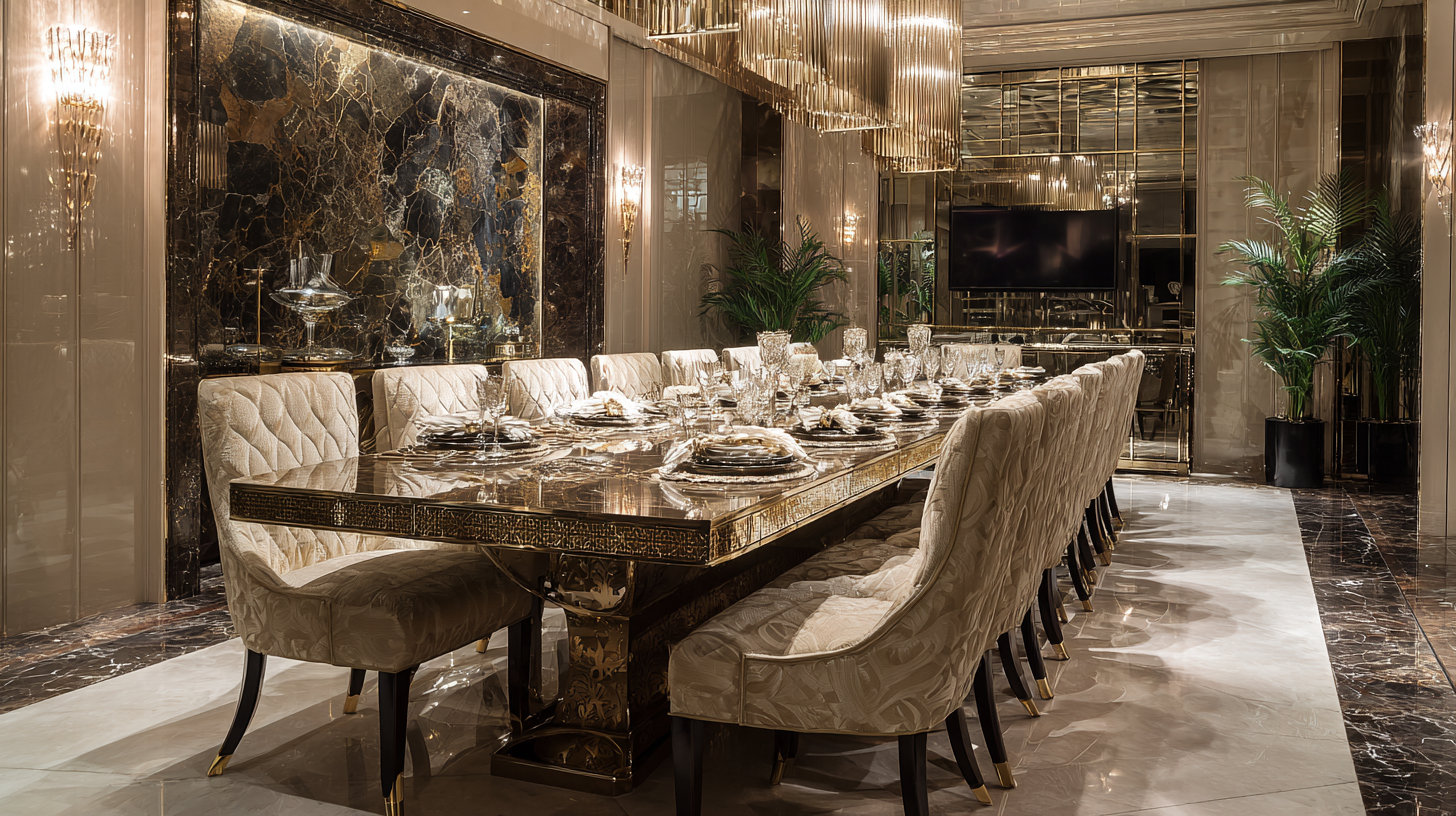As we look towards 2025, the dining table market is poised for significant transformation, influenced by changing consumer preferences and innovative designs. According to a market research report by Grand View Research, the global dining table market is expected to reach USD 12 billion by 2025, growing at a compound annual growth rate (CAGR) of 5.8% from 2019 to 2025. This growth is driven by the rising trend of open-concept living spaces and the increasing emphasis on home dining experiences.

Diverse materials, such as reclaimed wood, metal, and glass, are becoming popular as consumers seek both functionality and aesthetic appeal in their dining environments. Moreover, ergonomic designs and multifunctional tables are emerging to cater to the demands of modern lifestyles. This blog will explore the characteristics and applicability of different types of dining tables, providing insights into innovative examples that reflect future trends in the market.
As we look ahead to 2025, the dining table market is set to undergo transformative changes, driven significantly by the integration of emerging materials. According to a recent report by Grand View Research, the global furniture market is projected to reach USD 650 billion by 2025, with dining tables representing a crucial segment. Innovative materials such as engineered wood, recycled composites, and even bioplastics are becoming increasingly popular, answering the growing demand for sustainability without compromising style or durability.
 Engineered wood, in particular, has emerged as a frontrunner in dining table construction due to its resilience and versatility. Notably, a study from the American Society of Interior Designers highlights that nearly 60% of consumers now prioritize eco-friendly materials in their purchases. Additionally, the use of recycled metal and glass components is gaining traction, appealing to modern aesthetics while promoting a circular economy. Companies like IKEA are leading the charge, utilizing these innovative materials to create multifunctional designs that cater to the evolving needs of consumers, setting a new standard for the industry as we move towards 2025.
Engineered wood, in particular, has emerged as a frontrunner in dining table construction due to its resilience and versatility. Notably, a study from the American Society of Interior Designers highlights that nearly 60% of consumers now prioritize eco-friendly materials in their purchases. Additionally, the use of recycled metal and glass components is gaining traction, appealing to modern aesthetics while promoting a circular economy. Companies like IKEA are leading the charge, utilizing these innovative materials to create multifunctional designs that cater to the evolving needs of consumers, setting a new standard for the industry as we move towards 2025.
As we look ahead to 2025, the dining table market is poised for an exciting transformation driven by smart technology integrations. Modern consumers are increasingly seeking multifunctional furniture that seamlessly fits into their tech-savvy lifestyles. Dining tables are evolving to become more than just surfaces for meals; they are now interactive hubs equipped with features that enhance convenience and connectivity. Imagine a dining table that can adjust its height at the touch of a button or one that includes built-in wireless charging stations for devices, making mealtime both enjoyable and efficient.
Moreover, the integration of smart technology allows for the customization of dining experiences. Innovative designs are emerging that incorporate mood lighting controlled via smartphone apps, creating the perfect atmosphere for any occasion. Voice-activated systems can even help manage playlists or order food, making the dinner experience more enjoyable and relaxed. As these advancements continue to develop, dining tables will likely reflect the growing demand for connectivity, functionality, and style, offering a glimpse into a future where technology and dining converge in extraordinary ways.
As the dining tables market continues to evolve, sustainable practices are becoming a central theme for innovation, particularly looking ahead to 2025. Manufacturers are increasingly focusing on eco-friendly materials and production methods that minimize environmental impact. This shift not only caters to the growing consumer demand for sustainable products but also aligns with global efforts to combat climate change. By utilizing reclaimed wood, bamboo, and recycled metals, brands are creating dining tables that combine style with environmental responsibility.
In addition to materials, innovative designs are revolutionizing how we think about dining spaces. Features such as modular tables that can be easily adapted for different uses and spaces reflect a commitment to versatility and sustainability. Furthermore, advancements in energy-efficient lighting solutions complement these dining tables, enhancing the overall dining experience while reducing energy consumption. With a blend of creativity and sustainability, the dining table market is poised to offer unique solutions that not only meet aesthetic demands but also promote a greener future.
 As the dining tables market evolves, customization has emerged as a leading trend, reshaping the way consumers experience their dining spaces. Today’s consumers are seeking unique and personalized dining solutions that reflect their individual styles and preferences. This shift towards tailor-made dining experiences is encouraging manufacturers to innovate and diversify their offerings. From customizable sizes and finishes to modular designs that adapt to different lifestyles, the options are endless.
As the dining tables market evolves, customization has emerged as a leading trend, reshaping the way consumers experience their dining spaces. Today’s consumers are seeking unique and personalized dining solutions that reflect their individual styles and preferences. This shift towards tailor-made dining experiences is encouraging manufacturers to innovate and diversify their offerings. From customizable sizes and finishes to modular designs that adapt to different lifestyles, the options are endless.
When considering customization for your dining table, think about how the piece can enhance your overall experience. Tip: Personalize with interchangeable components, like tablecloths or placemats in different materials and colors, allowing you to change the atmosphere with ease. Additionally, consider the functionality that suits your lifestyle. Tip: Opt for extendable tables that can accommodate varying guest numbers, offering flexibility for gatherings or intimate meals.
Moreover, sustainable practices are becoming integral in customization trends. Consumers are increasingly looking for materials that are eco-friendly and ethically sourced. Tip: Research manufacturers who offer reclaimed wood options or sustainably harvested materials, giving you a dining table you can feel good about while also enhancing your home decor. Embracing these customization trends will not only elevate your dining experience but also ensure your table is a true reflection of your personality and values.
As we approach 2025, the dining table market is evolving to meet the demands of modern living, particularly in urban environments where space is at a premium. Multifunctional dining tables are becoming increasingly popular, offering innovative solutions that merge aesthetics with practicality. According to a recent industry report, the multifunctional furniture market is projected to grow at a CAGR of 7.5% through 2025, driven by consumers' desire for versatile home furnishings that maximize limited space.
These dining tables are designed not only for eating but also for working, socializing, and even storage. Many models feature extendable surfaces or integrated storage solutions, allowing homeowners to adapt their dining areas for various activities. The trend reflects a broader move towards minimalism and natural materials, as consumers seek furnishings that are not only stylish but also sustainable and practical. The integration of smart technology into furniture design adds another layer of adaptability; for instance, tables equipped with wireless charging capabilities cater to the tech-savvy lifestyle, making them essential in today's homes.
| Feature | Current Trend (%) | Expected Trend by 2025 (%) | Market Segment |
|---|---|---|---|
| Space-Saving Design | 45 | 70 | Urban Living |
| Multi-Functionality (e.g., expandable, storage) | 30 | 55 | Small Apartments |
| Sustainability (eco-friendly materials) | 25 | 50 | Environmentally Conscious Consumers |
| Customization Options | 20 | 40 | Personal Home Decor |
| Smart Technology Integration | 10 | 35 | Tech-Savvy Users |
